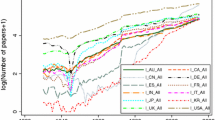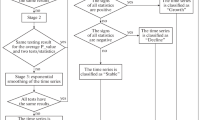Abstract
The study demonstrates an integrated method of forecasting the trend of a country’s publications. In this context the paper examines international collaboration in a country’s overall publication and forecasts its future trend. The integrated method is based on regression and scaling relationship. India is taken as a case study for this examination. The study shows some interesting features of India’s publication pattern based on time-series data. One observes exponential nature of her publication growth from 2002 onwards. International collaboration also exhibits exponential growth roughly from the same period. Also one observes the faster growth of international collaborative papers than the overall growth of research papers. The study predicts values of number of internationally collaborative papers for the years 2015 and 2020. The robustness of the method is also demonstrated.







Similar content being viewed by others
References
Archambault, E., Beauchesne, O.H., Cote, G., & Roberge, G. (2011). Scale-adjusted metrices of scientific collaboration In: Proceedings of the 13th international society for scientometrics & informetrics, Edited by Ed. Noyons, Patrick Ngubube & Jacqueline Leta. ISSI, Leiden University 7 University of Zululand, 78–88.
Bhattacharya, S (2013). Unit 15 scientometric studies and their role in science policy. Published by INFLIBNET for e-PG pathashala learning management system. National mission of education through ICT.
Chen-Yuan, L., & Jhen-Cheng, W. (2010). Forecasting the development of the biped robot walking technique in Japan through S-curve model analysis. Scientometrics, 82(1), 21–36.
Cheng, A.-C., & Chen, C.-Y. (2008). The technology forecasting of new materials: The example of nanosized ceramic powders. Romanian Journal of Economic Forecasting, 5(4), 88–110.
Daim, T., Rueda, G., & Martin, H. (2005). Technology forecasting using bibliometric analysis and system dynamics. Technology management: A unifying discipline for melting the boundaries, 112–122.
Firat, A.K., Woon W.L., & Madnick, S. (2008). Technology forecasting- A review. Working Paper CISL#2008-15, Massachusetts Institute of Technology, Cambridge.
Glanzel, W., & Schubert, A. (2001). Double effort = double impact? A critical view at international co-authorship in chemistry. Scientometrics, 50(2), 199–214.
Katz, J. S. (2000). Scale-independent indicators and research evaluation. Science and Public Policy, 27(1), 23–36.
Katz, J. S. (2005). Scale-independent bibliometric indicators. Measurement, 3(1), 24–28.
Katz, J. S. (2006). Indicators for complex innovation systems. Research Policy, 35, 893–909.
Kwasnicka, H., & Kwasnicki, W. (1992). Market, innovation, competition: An evolutionary model of industrial dynamics. Journal of Economic Behavior & Organization, 19, 343–368.
Kwasnicki, W., & Kwasnicki, H. (1996). Long term diffusion factors of technological development: An evolutionary model and Case study. Technology Forecasting and Social Change, 52(1), 31–57.
Schubert, A., & Glanzel, W. (2006). Cross-national preference in co-authorship, references and citations. Scientometrics, 69(2), 409–428.
Skiadas, C. (1985). Two generalized rational models for forecasting innovation diffusion. Technology Forecasting and Social Change, 27, 39–61.
Wagner, C. S. (2008). The new invisible college. Washington, D.C: Brooking Institution Press.
Acknowledgments
This study comes from the project undertaken by Mr Varun Shrivats during internship at CSIR-NISTADS. The project was part of the overall study of analysing India’s scientific competency led by Dr Sujit Bhattacharya. We express our thanks to CSIR-NISTADS and Birla Institute of Technology and Science Pilani, Goa campus for providing the opportunity to undertake this study.
Author information
Authors and Affiliations
Corresponding author
Rights and permissions
About this article
Cite this article
Varun Shrivats, S., Bhattacharya, S. Forecasting the trend of international scientific collaboration. Scientometrics 101, 1941–1954 (2014). https://doi.org/10.1007/s11192-014-1364-x
Received:
Published:
Issue Date:
DOI: https://doi.org/10.1007/s11192-014-1364-x




